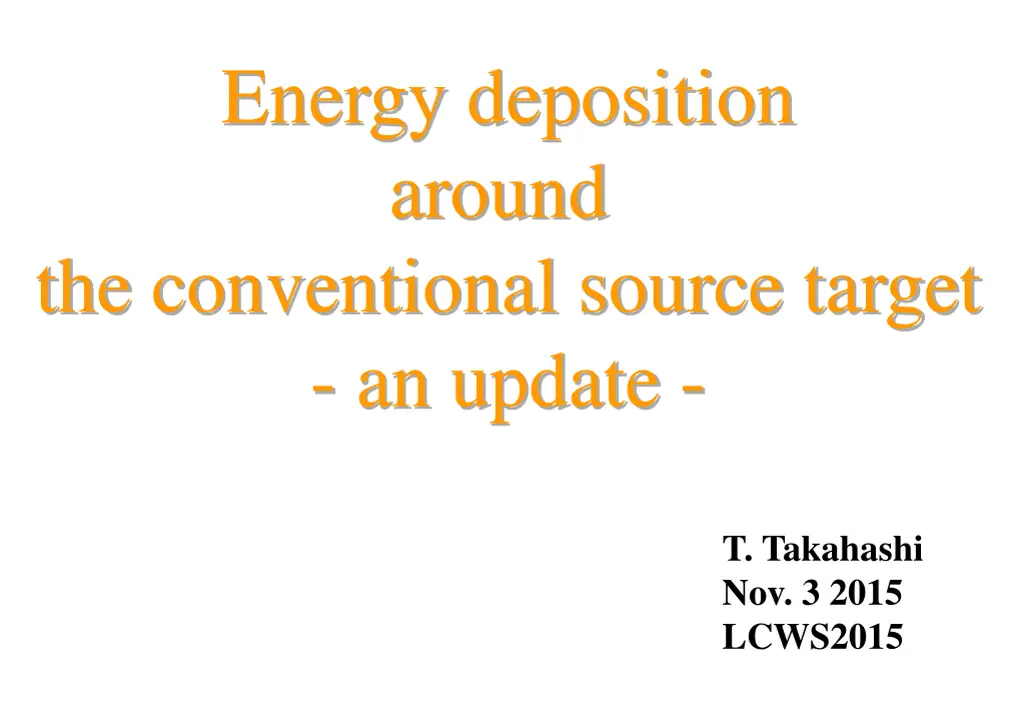
Update on Energy Deposition around Conventional Source Target
Explore the energy deposition around a conventional source target and the impact of charged particles on downstream components. Learn about the calculation of energy deposition profiles and the evaluation of accelerator components. Various models and simulations are discussed to understand the energy deposition process in detail.
Download Presentation

Please find below an Image/Link to download the presentation.
The content on the website is provided AS IS for your information and personal use only. It may not be sold, licensed, or shared on other websites without obtaining consent from the author. If you encounter any issues during the download, it is possible that the publisher has removed the file from their server.
You are allowed to download the files provided on this website for personal or commercial use, subject to the condition that they are used lawfully. All files are the property of their respective owners.
The content on the website is provided AS IS for your information and personal use only. It may not be sold, licensed, or shared on other websites without obtaining consent from the author.
E N D
Presentation Transcript
Energy deposition around the conventional source target - an update - T. Takahashi Nov. 3 2015 LCWS2015 1
Contents Motivation at PosiPol2015 some Update issues
Why Energy deposition due to charged particles on down stream components is larger than the undulator target. Flux concentrator, booster linac Not just a cooling issues, affects operation of the linac need to evaluate in detail.
A Model We need a realistic arrangement of accelerator components to evaluate the energy deposition, which is yet to be fixed. Using a simple model to get a rough estimate RF structure: a solid tube Cu FC: a cone Cu 16 60 W Target
Ee = 6 GeV, target thickness 14 mm sigma of E beam = 4.0mm 250 6.0 kW GeV kw/cm energy deposit = 4mm 35kW 161kW 36kW total inner 20 mm inner 10 mm yield: 1.3e+/e- PEDD 23J/g energy deposit density kW/cm^3 2.5 2.0 1.5 1.0 0.5 0.1 0.05 0.01 r(mm) 80kW in first 1.27m 1.4kW/cm^ 3 z (mm)
Ee=4.8GeV 2 70 35 yield e+/e (left total deposit (right 1.8 60 30 1.6 total deposit (kW) yields (e+/e-) 50 1.4 PEDD (J/g) 25 1.2 40 20 1 30 0.8 15 0.6 20 10 0.4 10 0.2 5 0 0 0 0 10 20 30 40 0 5 10 15 20 25 30 35 thickness (mm) thickness (mm) Simulation performed with the same condition with Kiriki at 16mm 1.3 e+/e- 40kW on the target PEDD 30J/g
Ee = 4.8GeV, target thickness 16 mm sigma of ebeam=4.0mm 200 4.8 kW GeV kw/cm = 4mm energy deposit 40kW 111kW 37kW total inner 20 mm inner 10 mm yield: 1.3e+/e- PEDD 23J/g energy deposit density kW/cm^3 2.5 2.0 1.5 1.0 0.5 0.1 0.05 0.01 r(mm) 66kW in first 1.27m 1.4kW/cm^3 z (mm)
Ee = 4.8GeV, target thickness 16 mm sigma of E beam = 3.5mm 200 4.8 kW GeV kw/cm = 3.5mm energy deposit 40kW 117kW 33kW total inner 20 mm inner 10 mm yield: 1.55e+/e- PEDD 30J/g energy deposit density kW/cm^3 2.5 2.0 1.5 1.0 0.5 0.1 0.05 0.01 r(mm) 67kW in first 1.27 m 1.0kW/cm^3 z (mm)
Summary and outlook Energy deposition normalized for 3.0 1010 e+/bunch after capture linac E electron (GeV) P electron (kW) sig electron (mm) PEDD target (J/g) E dep. Target (kW) E depo. FC (kW) E dep. Acc (kW) E dep. Acc 1.27m (kW) 6.0 292 4.0 27 40 42 186 92 4.8 4.8 292 193 4.0 3.5 27 29 46 39 43 32 128 113 76 65 Should energy deposition around the target cooling, temperature control need to put more realistic geometry in the simulation

